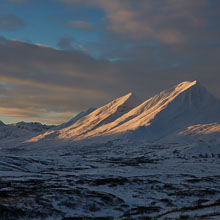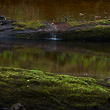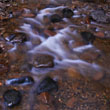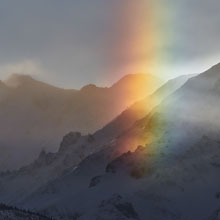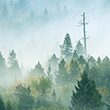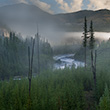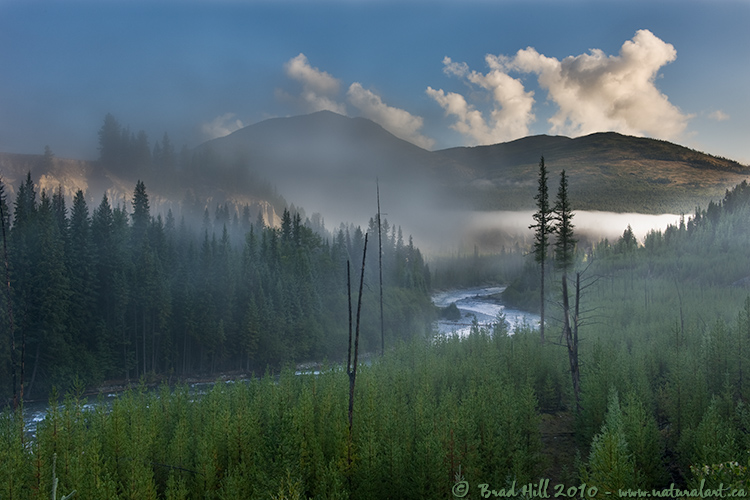
Availability: Undetermined - Enquiries?
In the Field
Foggy Findlay. Findlay Creek, BC, Canada. September 7, 2008.
Hey...what's a "wildlife guy" doing shooting images like this? Well...I shot it partly to dispel the notion that I'm JUST a "wildlife photographer". But I also shot this because I'm a fog and mist junkie and, most importantly, it was simply an awesome scene! And only 10 km from my home! Bonus!
About the scene: Findlay Creek is a mountain stream that runs for about 50 km from its alpine source high in the Purcell Mountains of southeast British Columbia to its terminus in the Kootenay River in the Rocky Mountain Trench. The portion in this image is located about 20 km upstream from the Kootenay and runs through a mixed pine and fir forest. The lighter green and smaller confirs in the foreground are Lodgepole Pine that are re-colonizing a section of forest that burned about a dozen years ago. The darker, taller and mist enshrouded trees on the opposite side of the stream are Douglas Firs that escaped the fire. The image was shot just after sunrise on a cool morning - it was just above freezing when I captured the image and the morning fog was just burning off.
About the capture and processing: The brightness (or dynamic) range of this image was off the charts! I knew from past experience that it was far beyond what any current digital sensor could capture in a single image. So I captured multiple images over a 2 stop range and, and after processing the raw files I combined them in Photoshop to produce the single image you're looking at now. This was the only way I could render the scene as it appeared to my eye. With any single exposure (whether film or digital) you could accurately represent only a portion of this image - either the bright regions (billowy clouds, hanging fog, highlighed gravel hoodoos) or the shaded regions (dark fir forest, detail in the lower portion of the pine forest - but not both. Besides adding pure visual interest, the fog assisted me by provding the perception of depth to the image, which is almost always a critical element in landscape photography.
Is it legitimate to use this kind of digital "magic" in producing an image or is it "cheating"? While some purists might disagree, I would argue that because the digital correction is in the direction of increasing the "reality" (i.e., making it more similar to how it appeared to the naked eye) of the image, it is totally legitimate. It's very likely that in 5 or so years digital sensors will have improved to the point where "extending" the dynamic range of a single capture won't be necessary - at this point I'm sure it won't be considered "cheating"! And, of course, the technique I applied to this image is really nothing more than the digital equivalent of using a graduated neutral density filter.
Behind the Camera
Foggy Findlay. Findlay Creek, BC, Canada. September 7, 2008.
Digital Capture; Compressed RAW (NEF) 12-bit format; ISO 200.
Nikon D700 with AF-S Nikkor 24-70 mm f/2.8G IF-ED lens equipped with polarizing filter and supported on Gitzo G2220 tripod with AcraTech Ultimate ballhead.
3 exposures: 1/25s @ f16 (no compensation from matrix-metered exposure setting); 1/50s @ f16 (-1.0 stop compensation from matrix-metered exposure setting); 1/100s @ f16 (-2 stop compensation from matrix-metered exposure setting).
At the Computer
Foggy Findlay. Findlay Creek, BC, Canada. September 7, 2008.
RAW Conversion of each exposure to 16-bit TIFF, including first-pass/capture sharpening and white balance adjustment using Adobe Camera Raw (v4.5).
Further digital corrections on 16-bit TIFF file using Adobe's Photoshop CS3 and Light Crafts LightZone. Photoshop adjustments included compositing and masking of all exposure versions, selective colour saturation and selective curves adjustment. LightZone used to make final adjustments to overall tonality of the scene (using Tonemapper/Relight tool).
Conservation
Foggy Findlay. Findlay Creek, BC, Canada. September 7, 2008.
Ten percent of the revenue generated by this image will be donated to Wildsight.
This tranquil scene was shot in the Columbia Valley of the East Kootenays. While the East Kootenays are often thought of as containing expansive areas of wilderness, many ecosystems within the Columbia Valley face development pressure, including pressure from logging operations. Wildsight is an effective conservation organization that protects biodiversity and promotes sustainable communities in Canada's Columbia and Rocky Mountains. Support for Wildsight, through donation or becoming a member, will help ensure that they remain effective in their efforts to conserve threatened or endangered species and ecosystems.


















